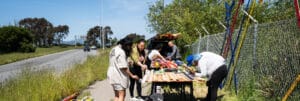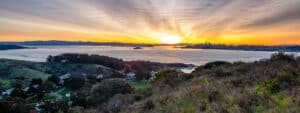By Lisa Vorderbrueggen

New Farm, the second iteration unveiled six years ago, is now Tassajara Parks, with as many as 158 single-family houses clustered on 30 acres and no agricultural operations.
In exchange for the houses, landowner and former Jordanian transportation minister Samir Kawar will donate 726 acres — 95 percent of his 771 acres — to the East Bay Regional Park District.
“While New Farm had many merits and opportunities, we heard what community stakeholders and leaders had to say about it,” said project spokesman David Bowlby of Alamo. “We decided to regroup and see if we could find a way to accomplish the property owner’s goals related to a development and do something that really benefits the community.”
Environmental organizations including Save Mount Diablo, Sierra Club and the Greenbelt Alliance are celebrating the landowner’s retreat as a major victory in the campaign to hold fast Contra Costa County’s voter-approved urban limit line.
“Tassajara Valley was critical,” Greenbelt Alliance senior field representative Matt Vander Sluis said. “There are 40 urban limit lines in the Bay Area, and if one breaks, it could open the floodgates everywhere.”
Tassajara Valley, a region of grassy knolls east of Danville and San Ramon used for cattle grazing, has been outside the county’s growth boundary since 2000. Landowners must win voter approval for more intense building there.
But the New Farm proposal submitted in 2007 — 185 mostly large estate houses interspersed with irrigated orchards and vineyards — called for the county to craft a new land use category and sidestep a public vote.
Critics blistered the plan, dubbing it “Fake Farm” and characterizing it as an end-run around the county’s growth boundary.
While the project stalled for six years in the ailing real estate market, its existence galvanized environmentalists and community activists who have for years feared Tassajara would become another Dougherty Valley, a mostly built-out development to the south.
The environmental groups banded together and hired a high-powered environmental law firm to help challenge New Farm.
The coalition also helped defeat a line expansion measure in Brentwood in June 2010.
More significantly, they successfully squashed a San Ramon-sponsored boundary expansion in November 2010 that would have placed 1,600 acres in Tassajara Valley within the city’s urban limit line.
With few politically realistic options left, Kawar is shifting to a more conventional housing project and donating a nearly unprecedented percentage of his property to the park district.
“We’re looking at it pretty positively, especially given the proposals for more intense development there,” said Bob Nisbet, assistant general manager for the lands division at regional park district. “It’s an incredible piece of property. There are lots of possibilities for regional trail connections and shorter loop trails.”
The newly named Tassajara Parks restricts housing to less than 30 acres along Camino Tassajara near Blackhawk and Alamo Creek developments.
Urban limit line changes of 30 acres or less don’t require a public vote but do need a four-fifths vote of the Board of Supervisors.
Kawar’s consulting team is further revising the Tassajara Parks site plan based on concerns aired at recent meetings with San Ramon Valley officials and environmentalists.
The landowner is also offering to donate 5 acres to the San Ramon Valley Fire District for a training center and another 5 acres adjacent to the Tassajara Valley elementary school, which would enable a plan to relieve serious traffic problems there.
This article was originally published in the Contra Costa Times. Link to article
Timeline: Tassajara Valley
1990s — Former Jordanian transportation minister Samir Kawar, along with adjacent landowners, form the Tassajara Valley Property Owners Association and float plan for 6,000 houses on their combined 5,000 acres.
2000 — Contra Costa Board of Supervisors contracts the countywide urban limit line in Tassajara Valley, among other places. Building outside the line requires a countywide vote. Tassajara Valley landowners abandon the 6,000-house plan.
2004 — Contra Costa County voters reaffirm on a 64-36 percent vote the contracted urban limit line.
2007 — Through FT Land LLC, Kawar proposes a scaled down “New Farm,” a mix of 185 houses interspersed with irrigated orchards, roadside farm stands and other uses on 771 acres.
November 2010 — On a 72-28 percent vote, San Ramon residents defeat a city-sponsored urban growth boundary expansion measure that would have included 1,600 acres in Tassajara Valley.
February 2013 — Kawar downsizes his plan again. Renamed Tassajara Parks, the new plan calls for as many as 158 single-family houses clustered on 30 acres. As part of the deal, he would donate 726 acres to the East Bay Regional Park District.




